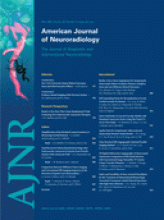Abstract
BACKGROUND AND PURPOSE: Stent-assisted revascularization increases prevailing recanalization rates (≅50%–69%) for vessel occlusions recalcitrant to thrombolytics. Although balloon-mounted coronary stents can displace thrombus (via angioplasty) and retain clot along vessel walls, intracranial self-expanding stents are more flexible and exert less radial outward force during deployment, increasing deliverability and safety. To understand the effectiveness of self-expanding stents for recanalization of acute cerebrovascular occlusions, we retrospectively reviewed our preliminary experience with these stents.
MATERIALS AND METHODS: Eighteen patients (19 lesions) presenting with a clinical diagnosis of acute stroke underwent catheter-based angiography documenting focal occlusion of an intracranial artery. A self-expanding stent was delivered to the occlusion and deployed. Stent placement was the initial mechanical maneuver in 6 cases; others involved a combination of pharmacologic and/or mechanical maneuvers prestenting. GP IIb/IIIa inhibitors were administered in 10 cases intraprocedurally or immediately postprocedurally to avoid acute in-stent thrombosis.
RESULTS: Stent deployment at the target occlusion (technical success) was achieved in all cases. Thrombolysis in Cerebral Ischemia (TICI)/Thrombolysis in Myocardial Ischemia (TIMI) 2/3 recanalization (angiographic success) was achieved in 15 of 19 lesions (79%). All single-vessel lesions (n = 8) were recanalized, but only 7 of 11 combination internal carotid artery and middle cerebral artery lesions were recanalized. No intraprocedural complications occurred. Seven in-hospital deaths occurred: stroke progression, 4; intracranial hemorrhage, 2; respiratory failure, 1. Seven patients had ≥4-point National Institutes of Health Stroke Scale improvement within 24 hours after the procedure, 6 had modified Rankin Score (mRS) ≤3 at discharge, and 4 had mRS ≤3 at 3 months. Overall, revascularization and improvement in clinical outcome were more likely to occur in women.
CONCLUSION: Feasibility of self-expanding stents for treatment of acute symptomatic intracranial occlusions is shown. For single-vessel lesions, stent placement with concomitant administration of IIb/IIIa inhibitors contributed to the achievement of recanalization rates exceeding those currently reported for other means of thrombolysis.
- Copyright © American Society of Neuroradiology












